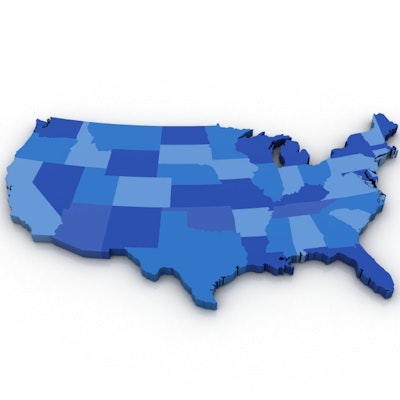
Use of mammography screening services in the Medicare population varies at the U.S. county level and is lowest in rural counties, according to a study published online July 17 in the American Journal of Roentgenology.
The findings support previous research suggesting that women in rural areas are more likely than those in urban ones to be diagnosed with later-stage breast cancer -- which implies a lack of awareness of breast cancer screening or access to it, wrote a team led by Dr. Samantha Heller, PhD, of NYU Langone Medical Center.
"Despite evidence showing that mammographic screening lowers mortality, high breast cancer mortality persists in the United States and is unevenly distributed geographically," the researchers wrote. "In particular, we found that rural counties and small urban counties showed lower uptake rates than metropolitan and large urban counties."
To explore county-level geographic patterns of breast cancer screening, Heller and colleagues used County Health Rankings data to identify the percentage of Medicare enrollees per U.S. county between the ages of 67 and 69 who had at least one mammogram in 2012 or 2013. Counties were classified as metropolitan or nonmetropolitan based on a scale of 1 to 9 from the U.S. Department of Agriculture's Atlas of Rural and Small-Town America categories, with large urban areas defined as more than 20,000 people and small urban areas as fewer than 20,000.
During the study time frame, 2.2 million Medicare beneficiaries were eligible for mammograms. National mean uptake of mammography screening services was 60.5%, with a range of 26% to 86% by state, the researchers found.
In nine states, the use of screening mammography was significantly higher in metropolitan and large urban counties than their more rural counterparts.
| States with higher urban vs. rural per-county mean screening mammography uptake | ||
| State | Rural or small urban counties | Metropolitan or large urban counties |
| Alabama | 59.5% | 63.1% |
| Arkansas | 54.3% | 59.5% |
| Arizona | 47.6% | 62.3% |
| Florida | 63.1% | 67% |
| Kentucky | 52.6% | 60.4% |
| Louisiana | 55% | 60.8% |
| Montana | 58.3% | 66.5% |
| Nebraska | 59% | 60.5% |
| Texas | 51.2% | 56.7% |
Michigan was the only state in which mammography uptake was significantly lower in metropolitan and large urban counties than in more rural counterparts (66.2% versus 68.2%); county differences were not statistically significant in the remaining states, according to the researchers.
"On the county level, we found that both small urban counties and rural counties -- regardless of state and regardless of whether these counties were adjacent to metropolitan centers -- were associated with lower screening uptake, suggesting that counties can be more meaningfully classified with respect to both population density and metropolitan influence rather than as simple metropolitan versus nonmetropolitan," the group noted.
The researchers also found that county-level mammographic uptake positively correlated with the percentage of residents with some college education and negatively correlated with age-adjusted mortality.
County-level research on screening mammography offers a more nuanced picture, Heller and colleagues concluded.
"Our findings paint a portrait of uneven healthcare uptake within a Medicare population and suggest a means of identifying counties that may benefit from focused screening intervention and education," they wrote.




















